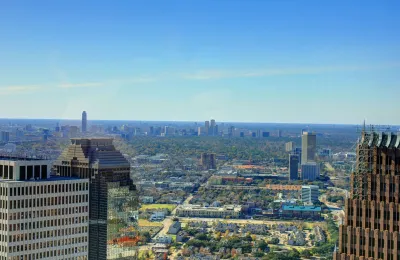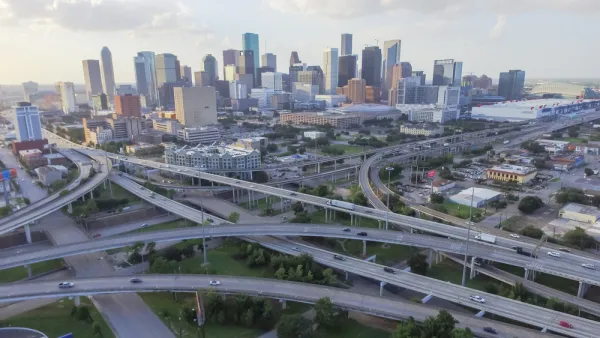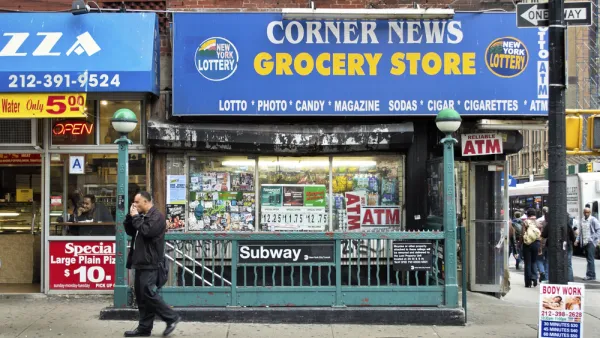The extra costs of automobile dependency turn assumptions about affordability on their head, according to a recently published report by the Citizens Budget Commission.

Peter Holley writes on the changes that rapid growth have brought to Houston, and the underappreciate costs of living in a sprawling city:
Though we don’t have up-to-date grotto figures, several million people found Houston’s sales pitch compelling enough to move to the Bayou City in recent decades, with the region gaining 1.1 million residents since 2010 alone, according to the Greater Houston Partnership. Outside a few ritzy pockets intimately tied to oil prices, the city evolved into a sprawling mass of suburban affordability—a Levittown on steroids for the new American South.
According to Holley, the "seemingly endless suburban growth" has had a "crucial downside" that doesn't have to do with repeated, catastrophic flooding: increasing housing costs.
While the seemingly endless suburban growth has traditionally offered the city the veneer of affordability, the sprawl has also spiked transportation costs, so much so that the city’s combined transportation and living costs now place it on par with New York City….
The conclusion comes from a report by the Citizens Budget Commission, titled "Rent and Ride."
"Monthly median housing costs in Houston in 2016 (the most recent year data was available) were $1,379, nearly $400 less than New York City. However, median transportation costs were $1,152, a figure 38 percent higher than for New Yorkers," according to Holley. "In total, the study found, living in Houston was only $79 cheaper each month than New York."
Planetizen blogger and founder and executive director of the Victoria Transport Policy Institute Todd Litman has done similar work to document a more clear and thorough picture of affordability based on transportation costs, as exemplified in the following posts, among others.
- More Critique of Demographia's International Housing Affordability Survey (January 2015)
- Study: Sprawl Costs the U.S. Economy $1 Trillion Annually (March 2015)
- Smart Growth Policies for Urban Affordability and Fertility (February 2016)
- The International Sprawl Tax (June 2016)
- Unaffordability is a Problem but Sprawl is a Terrible Solution (February 2017)
- Houses Appreciate. Cars Depreciate. Walkable Urban Neighborhoods Help Families Build Wealth. (August 2017)
- True Affordability: Critiquing the International Housing Affordability Survey (March 2018)
- Understanding Location-Efficient Affordability Impacts (April 2018)
FULL STORY: Houston Is Now Less Affordable Than New York City

Analysis: Cybertruck Fatality Rate Far Exceeds That of Ford Pinto
The Tesla Cybertruck was recalled seven times last year.

National Parks Layoffs Will Cause Communities to Lose Billions
Thousands of essential park workers were laid off this week, just before the busy spring break season.

Retro-silient?: America’s First “Eco-burb,” The Woodlands Turns 50
A master-planned community north of Houston offers lessons on green infrastructure and resilient design, but falls short of its founder’s lofty affordability and walkability goals.

Test News Post 1
This is a summary

Analysis: Cybertruck Fatality Rate Far Exceeds That of Ford Pinto
The Tesla Cybertruck was recalled seven times last year.

Test News Headline 46
Test for the image on the front page.
Urban Design for Planners 1: Software Tools
This six-course series explores essential urban design concepts using open source software and equips planners with the tools they need to participate fully in the urban design process.
Planning for Universal Design
Learn the tools for implementing Universal Design in planning regulations.
EMC Planning Group, Inc.
Planetizen
Planetizen
Mpact (formerly Rail~Volution)
Great Falls Development Authority, Inc.
HUDs Office of Policy Development and Research
NYU Wagner Graduate School of Public Service




























